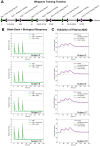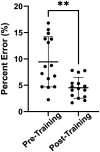Modeling biomarker kinetics of Aβ levels in serum following blast
- PMID: 40255887
- PMCID: PMC12006977
- DOI: 10.3389/fneur.2025.1548589
Modeling biomarker kinetics of Aβ levels in serum following blast
Abstract
Elucidating the unique neuropathological response to blast exposure remains a barrier towards the development of diagnostic approaches for those with blast-induced traumatic brain injury (bTBI). Quantification of biomarker concentrations in the blood post-injury is typically used to inform brain injury severity. However, injury progression and associated changes in biomarker concentrations are sensitive to parameters such as the blast overpressure (BOP) magnitude and frequency of blast exposure. Through this work, a blast-dose biomarker kinetics (BxK) platform was developed and validated for Aβ42 as a promising predictor of injury post-blast. Blast-dose responses accounting for BOP magnitude and frequency were integrated into a mathematical model accounting for whole-body Aβ peptide kinetics. Validation of the developed model was performed through comparison with acute monomer levels in the blood serum of 15 service members exposed to repeated low-level blast while undergoing three-day weapons training. Amyloid precursor protein (APP) synthesis was assumed to be proportional to blast magnitude and additive effects within a window of recovery were applied to account for cumulative exposure. Aβ42 concentrations in the blood serum were predicted within 6.5 ± 5.2% on average, demonstrating model feasibility and biomarker sensitivity to blast. Outcomes discuss how modulation of patient-specific factors (age, weight, genetic factors, years of exposure, sleep) and pathophysiological factors (BBB permeability, amyloidogenic pathology, neuroinflammation) can reveal potential sources of variability in experimental data and be incorporated into the blast-dose BxK platform in future iterations. Advancements in model complexity accounting for sex-specific factors, weapon system, stress levels, risk of symptom onset, and pharmacological treatment strategies are anticipated to improve model calibration. Utilization of this blast-dose BxK model to identify drivers of pathophysiological mechanisms and predict chronic outcomes has the potential to transform bTBI diagnostic, prognostic, and therapeutic strategies.
Keywords: Aβ42; biomarker; blast; brain; diagnostics; modeling; serum.
Copyright © 2025 Norris, Garimella, Carr, Boutté, Gupta and Przekwas.
Conflict of interest statement
CN, HG, and AP were employed by CFD Research Corporation. The remaining authors declare that the research was conducted in the absence of any commercial or financial relationships that could be construed as a potential conflict of interest.
Figures





Similar articles
-
Repeated Low-Level Blast Overpressure Leads to Endovascular Disruption and Alterations in TDP-43 and Piezo2 in a Rat Model of Blast TBI.Front Neurol. 2019 Jul 30;10:766. doi: 10.3389/fneur.2019.00766. eCollection 2019. Front Neurol. 2019. PMID: 31417481 Free PMC article.
-
Exposure to Low-Intensity Blast Increases Clearance of Brain Amyloid Beta.J Neurotrauma. 2024 Mar;41(5-6):685-704. doi: 10.1089/neu.2023.0284. Epub 2024 Jan 23. J Neurotrauma. 2024. PMID: 38183627
-
Fiscal Year 2018 National Defense Authorization Act, Section 734, Weapon Systems Line of Inquiry: Overview and Blast Overpressure Tool-A Module for Human Body Blast Wave Exposure for Safer Weapons Training.Mil Med. 2023 Nov 8;188(Suppl 6):536-544. doi: 10.1093/milmed/usad225. Mil Med. 2023. PMID: 37948275 Review.
-
Repetitive Low-Level Blast Exposure Improves Behavioral Deficits and Chronically Lowers Aβ42 in an Alzheimer Disease Transgenic Mouse Model.J Neurotrauma. 2021 Nov 15;38(22):3146-3173. doi: 10.1089/neu.2021.0184. Epub 2021 Sep 15. J Neurotrauma. 2021. PMID: 34353119 Free PMC article.
-
Exploring Calcium Channels as Potential Therapeutic Targets in Blast Traumatic Brain Injury.Pharmaceuticals (Basel). 2025 Feb 6;18(2):223. doi: 10.3390/ph18020223. Pharmaceuticals (Basel). 2025. PMID: 40006037 Free PMC article. Review.
References
LinkOut - more resources
Full Text Sources
Research Materials

